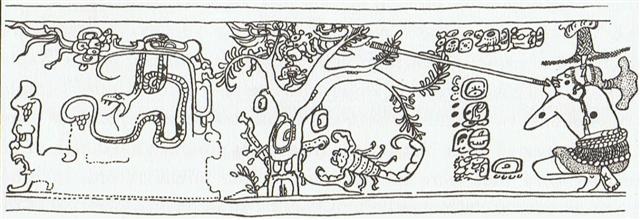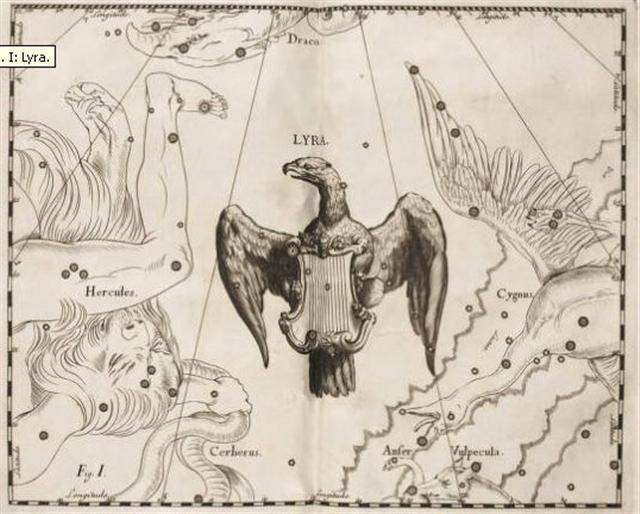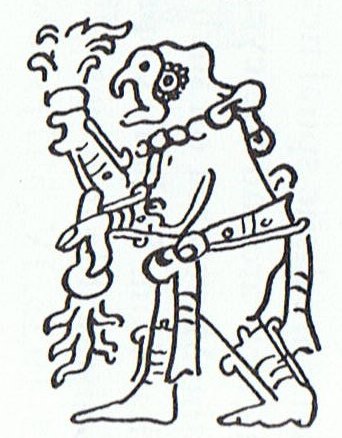232. Once again. The dates in the myth of the defeat of Itzam-Yeh (Seven-Macaw), alias Ursa Major, could have referred to the same time frame as its dates for the following Creation and for the day when Hun-Nal-Ye became the sky: ... the Palenque scribes repeated Creation again and described it as 'it was made visible, the image at Lying-down-Sky, the First-Three-Stone-Place'. Then we learned that five hundred and forty-two days later (1.9.2 in the Maya system), Hun-Nal-Ye 'entered or became the sky' (och ta chan). This 'entering' event occurred on February 5, 3112 B.C. The act of 'entering the sky' is recorded on another extraordinary painted pot.
This pot depicts one of the Hero Twins (One-Ahaw in the Classic texts and One-Hunaphu in the K'iche' Popol Vuh) and a great bird who is trying to land in a huge ceiba tree heavy with fruit. This mythical bird is Itzam-Yeh, Classic prototype of Wuqub-Kaqix, 'Seven-Macaw', of Popol Vuh fame. In that story, in the time before the sky was lifted up to make room for the light, the vainglorious Seven-Macaw imagined himself to be the sun. Offended by his pride, the Hero Twins humbled him by breaking his beautiful shining tooth with a pellet from their blowgun. This pot shows One-Ahaw aiming at the bird as he swoops down to land in his tree. As Itzam-Yeh lands on his perch, the text tells us he is 'entering or becoming the sky'. This particular 'sky-entering' is not the one mentioned in the Palenque text. It is the final event that occurred in the previous creation before the universe was remade. Before the sky could be raised and the real sun revealed in all its splendor, the Hero Twins had to put the false sun, Itzam-Yeh, in his place. If the date on this pot corresponds to that pre-Creation event, as we believe it does, then Itzam-Yeh was defeated in 12.18.4.5.0 1 Ahaw 3 K'ank'in (May 28, 3149 B.C.). After the new universe was finally brought into existence, First Father also entered the sky by landing in the tree, just as Itzam-Yeh did ...
If we could rely on the date for the last creation (21 May 3114 BC, 1st 3-stone place) and the date for the following sky entering (Och ta chan, 5 February) to belong in the same time frame as the date when Itzam-Yeh was defeated, we could then try to read ahead in the C text to position 141 (21 May) - 36 (5 February) = 105 on side b, i.e. to go from the 1st 3-stone place to the day of sky entering (och ta chan) of Hun-Nal-Ye. Likewise, we could go to position 105 + (28 May) - (21 May) = 112 in order to possibly find the day when Itzam-Yeh had been defeated:
Or should we not rather go back in the text because Itzam-Yeh was defeated before Hun-Nal-Ye 'became the sky' (och ta chan)?
To move ahead in the text implies moving back in time, because precession carries the Sun calendar (heliacal) dates forward compared to the positions of the fixed stars. The Sun will rise slightly earlier for each new year. Given - according to my assumption - a parallel between the sequence of glyph positions and the sequence of right ascension days, beginning half a year after 0h at day zero in the C text, day 281 counted from day zero will be at glyph number 280. This was where at the time of rongorogo in December 27 the Full Moon had reached Vega (the ancient star at the North Pole). Similarly, counting 112 days ahead from Polaris at the Full Moon will lead us to the ancient time when in 28 May 3149 BC the False Sun Itzam-Yeh (Ursa Major) was defeated, when Argo Navis was colliding with the Oak. 281 days (from Sirrah at the Full Moon in day zero to Vega at the Full Moon) + 112 (days from Polaris at the Full Moon to Miaplacidus at the Full Moon) = 393. From Vega at the Full Moon to Polaris at the Full Moon measured *365¼ + *26.6 - *281.8 = *110.0 right ascension days, or in the Sun calendar: 365 + 106 - 361 = 471 - 361 = 110 days. The number of glyphs on the G tablet was designed to be 471 (= 314 * 1½ = 16 * 29½ - 1). The Oak which was 'rammed' by Argo Navis probably had its roots far back in time: ... To conclude these enquiries we may say that if Balder was indeed, as I have conjectured, a personification of a mistletoe-bearing oak, his death by a blow of the mistletoe might on the new theory be explained as a death by a stroke of lightning. So long as the mistletoe, in which the flame of the lightning smouldered, was suffered to remain among the boughs, so long no harm could befall the good and kindly god of the oak, who kept his life stowed away for safety between earth and heaven in the mysterious parasite; but when once that seat of his life, or of his death, was torn from the branch and hurled at the trunk, the tree fell - the god died - smitten by a thunderbolt. And what we have said of Balder in the oak forests of Scandinavia may perhaps, with all due diffidence in a question so obscure and uncertain, be applied to the priest of Diana, the King of the Wood, at Aricia in the oak forests of Italy. He may have personated in flesh and blood the great Italian god of the sky, Jupiter, who had kindly come down from heaven in the lightning flash to dwell among men in the mistletoe - the thunder-besom - the Golden Bough - growing on the sacred oak in the dells of Nemi. If that was so, we need not wonder that the priest guarded with drawn sword the mystic bough which contained the god's life and his own. The goddess whom he served and married was herself, if I am right, no other than the Queen of Heaven, the true wife of the sky-god. For she, too, loved the solitude of the woods and the lonely hills, and sailing overhead on clear nights in the likeness of the silver moon looked down with pleasure on her own fair image reflected on the calm, the burnished surface of the lake, Diana's Mirror ...
|
||||||||||||||||||||||||||||||||||||||||||||||||||||||||||||||||||||||||||||||||||||||||||||||||||||||||||||||||||||||||||





.jpg)


